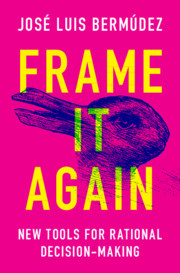Book contents
- Frame It Again
- Frame It Again
- Copyright page
- Contents
- Figures
- Tables
- Acknowledgments
- 1 Priming the Pump: Framing Effects and the Litany of Human Irrationality
- 2 Framing: The Classic Experiments
- 3 Where the Rubber Hits the Road: Investors, Frames, and Markets
- 4 Juliet’s Principle
- 5 Rational Frames?
- 6 Agamemnon and Climate Change
- 7 Framing Temptation and Reward: The Challenges of Self-Control
- 8 Chickens and Chariot Races: Framing in Game Theory
- 9 Fair’s Fair: Framing for Cooperation and Fairness
- 10 Getting Past No: Discursive Deadlock and the Power of Frames
- 11 Opening the Door to Non-Archimedean Reasoning
- Appendix Frames in the Brain
- Bibliography
- Index
5 - Rational Frames?
Published online by Cambridge University Press: 15 October 2020
- Frame It Again
- Frame It Again
- Copyright page
- Contents
- Figures
- Tables
- Acknowledgments
- 1 Priming the Pump: Framing Effects and the Litany of Human Irrationality
- 2 Framing: The Classic Experiments
- 3 Where the Rubber Hits the Road: Investors, Frames, and Markets
- 4 Juliet’s Principle
- 5 Rational Frames?
- 6 Agamemnon and Climate Change
- 7 Framing Temptation and Reward: The Challenges of Self-Control
- 8 Chickens and Chariot Races: Framing in Game Theory
- 9 Fair’s Fair: Framing for Cooperation and Fairness
- 10 Getting Past No: Discursive Deadlock and the Power of Frames
- 11 Opening the Door to Non-Archimedean Reasoning
- Appendix Frames in the Brain
- Bibliography
- Index
Summary
This is where we are after the first four chapters. On the one hand, it looks as though we fall prey to framing effects everywhere we turn, from supermarket shelves to our retirement accounts. On the other hand, accepted theories of how to make rational choices all hold that being susceptible to how outcomes are framed is a paradigm of irrationality. The psychologists Amos Tversky and Daniel Kahneman make this dilemma very vivid. They offer us two theories – expected utility theory and prospect theory. One (expected utility theory) is a normative theory – a theory of how rational agents are supposed to make decisions and navigate practical problems. The second (prospect theory) is a descriptive theory – a theory that has built into it much, if not all, of the irrationality condemned by the normative theory. And there is no chance, they clearly state, of bringing the two theories into harmony. The reality, they think, is that practical reasoning is irremediably irrational. And so, we have fuel for what I earlier called the litany of irrationality.
- Type
- Chapter
- Information
- Frame It AgainNew Tools for Rational Decision-Making, pp. 90 - 112Publisher: Cambridge University PressPrint publication year: 2020

